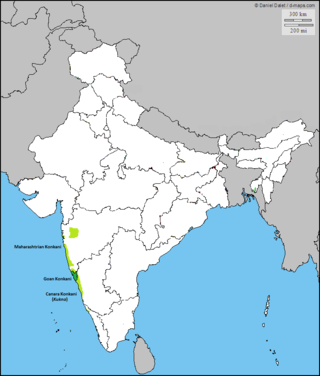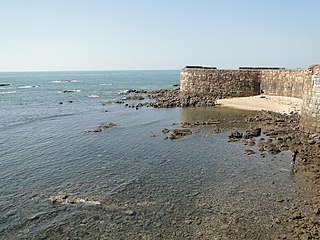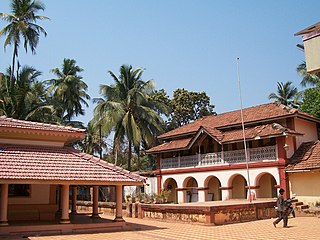
Urad bean or black gram is a bean grown in South Asia. Like its relative, the mung bean, it has been reclassified from the Phaseolus to the Vigna genus. The product sold as black gram is usually the whole urad bean, whereas the split bean is called white lentil. It should not be confused with the much smaller true black lentil.

Konkani is an Indo-Aryan language spoken by the Konkani people, primarily in the Konkan region, along the western coast of India. It is one of the 22 scheduled languages mentioned in the Indian Constitution, and the official language of the Indian state of Goa. It is also spoken in Karnataka, Maharashtra, Kerala, Gujarat as well as Damaon, Diu & Silvassa.

Sindhudurg district is an administrative district of the Konkan division in India, which was carved out of the erstwhile Ratnagiri district. The district headquarters are located at Oros. The district occupies an area of approximately 5,207 km2 and has a population of 849,651, of which 12.59% were urban. As of 2011, it is the least populous district of Maharashtra.
Malvani cuisine is the standard cuisine of the South Konkan region of the Indian states of Maharashtra and Goa. Although Malvani cuisine is predominantly non-vegetarian, there are many vegetarian dishes. Although it is an independent cuisine, it overlaps Maharashtrian cuisine and Goan cuisine. Malvan is a town in the Sindhudurg district on the west coast of Maharashtra.
The Konkani people are an Indo-Aryan ethnolinguistic group native to the Konkan region of the Indian subcontinent. They speak various dialects of the Konkani language. Following the Konkani language agitation, Konkani became the premier official language of Goa state, while Marathi remains as the associate official language of Goa. Konkani is also spoken by populations in Karnataka, Maharashtra, Damaon, Kerala, & Gujarat. A large percentage of Konkani people are bilingual.
Maharashtrian or Marathicuisine is the cuisine of the Marathi people from the Indian state of Maharashtra. It has distinctive attributes, while sharing much with other Indian cuisines. Traditionally, Maharashtrians have considered their food to be more austere than others.

Parsi cuisine refers to the traditional cuisine of the Parsi people who had migrated into the Indian subcontinent from Persia, and currently spread across the modern-day South Asian republics of India and Pakistan.
Sawantwadi is a taluka in the Sindhudurg district in the Indian state of Maharashtra. The taluka headquarters is Sawantwadi which has a municipal council, which is a local civic body. Sawantwadi was formerly the capital of the Kingdom of Sawantwadi, ruled by the Sawant Bhonsle dynasty
Malvan is a town and taluka in Sindhudurg District, the southernmost district of Maharashtra State, India, well known for the historically important Sindhudurg Fort. Malvan taluka consists of villages such as Angane Wadi, Masure, Achra, Khalchi Devli, Jamdul, Juva, Pankhol, Talasheel, Bandiwade and Sarjekot. The main occupation here is fishing and agriculture. The staple diet of the local people is fish curry and rice. The town produces Alphonso mangoes and is also known for sweets such as Malvani Khaja made from gram-besan flour and coated jaggery as well as Malvani Ladoos. Other sweets that attract tourists are Konkani Meva, Aambawadi, Fanaspoli, Kajuwadi, and Naralachya Wadya.

Konkani Muslims are an ethnoreligious subgroup of the Konkani people of the Konkani region along the west coast of India, who practice Islam. Nawayath and "Nakhuda" Muslims from the North Canara district of Karnataka have similar origin as Konkani Muslims, but show a distinct ethnolinguistic identity due to geographical isolation of the Canara coast from the Konkan coast.
Konkani cuisine is the cuisine of the Saraswat Brahmins from the Konkan region on the western coast of India. Konkani cuisine differs within the Saraswat Brahmin subsects and within the Konkan-Canara region. Konkani cuisine originally hails from the Konkan region including Uttara Kannada, Udupi district, Dakshina Kannada, Damaon, and Goa, India. Konkani cuisine is popular served in many restaurants throughout the western coast of India, and especially in the cities of Bombay and Bangalore. Each variation has its unique flavour and makes uses of different vegetables and fruits available in the region. Konkani cuisine is usually pesco-vegetarian, except acharyas and purohits who follow a strictly saatvik vegetarian diet. According the Konkani folklore, fish, meats are regarded as sea vegetables. Historically, they have refrained from eating any terrestrial animals in general.

A sanna is a spongy, steamed, and savoury unfilled dumpling originally made of red rice, black lentil and coconut in the Konkan region, by the western coast of the Indian subcontinent. They originated in Goa and Damaon, Mangalore, Bombay and Bassein (Vasai), and are especially popular among Goans, both the Goan Hindus and Goan Christians, and also among the Konkani migrants outside Konkan in Karachi, Sindh, Gujarat, Karnataka and Kerala. They are also loved by the people of the Konkan division, such as the Kupari of the Bombay East Indian community.

Asoli is a small village in Taluka Vengurla and district Sindhudurg of Maharashtra, India.

Kudaldeshkar Gaud Brahmin is a Brahmin sub-caste from the western coast of India, residing in the Konkan division of Maharashtra and Goa. They also known as Kudaldeshkar Aadya Gaud Brahmin, Kudaldeshkar and sometimes Kudalkar Brahmins. They speak Marathi, and the Malwani dialect of Konkani.

Maharashtri Konkani or Konkan Marathi, is a group of Konkanic dialects spoken in the Konkan division of the Konkan region. George Abraham Grierson, a British Indian linguist of the colonial era referred to these dialects as the Konkan Standard of Marathi in order to differentiate it inside the Konkani language group.

Shiroda is a small village in South Konkan in Vengurla taluka, Sindhudurg district, (Maharashtra), India, with a long stretch of beach. The village is famous for its pristine beach, weekly market, clothing shops, salt pans, fish market, and jetties. Small hillocks surround the region, along with mango and cashew plantations.
Redi is a village in the district of Sindhudurg in Maharashtra. Originally known as Rewati, Redi is located close to the shores of the Arabian Sea. Cashew and coconut trees grow in the region.

In Indian cuisine, dhal, parippu, pappu, or paruppu are dried, split pulses that do not require soaking before cooking. India is the largest producer of pulses in the world. The term is also used for various soups prepared from these pulses. These pulses are among the most important staple foods in South Asian countries, and form an important part of the cuisines of the Indian subcontinent.










